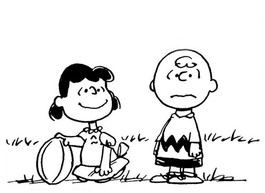Apocalyptic Peanuts

A few weeks ago Charles Schultz’s syndicated Peanuts cartoon went apocalyptic. Frame 1: Lucy to Charlie Brown, “I don’t worry about the world coming to an end anymore.” Frame 2: She continues, “The way I figure it, the world can’t come to an end today because it is already tomorrow in some other part of the world.” Frame 3: Lucy turns and asks Charlie Brown, “Isn’t that a comforting theory?” Final frame: Lucy smiling but Charlie Brown muttering, “I’ve never felt so comforted in all my life!” What do the end of the world and Christmas have to do with each other? One word: Advent. Which being interpreted, of course, means the Messiah’s coming. First time. Second time. Both times, “God with us.” Advent. The American lawyer and social activist, William Stringfellow, in his essay, “The Penitential Season,” bemoans the loss of meaning of this Advent season in America: “For all the greeting card and sermonic rhetoric, I do not think that much rejoicing happens around Christmastime, least of all about the coming of the Lord. There is, I notice, a lot of holiday frolicking, but that is not the same as rejoicing.” Why the loss of a deeper joy in this season? “The depletion of a contemporary recognition of the radically political character of Advent [i.e., “that message that in the coming of Jesus Christ, the nations and the principalities and the rulers of the world are judged in the Word of God”] is in large measure occasioned by the illiteracy of church folk about the Second Advent and, in the mainline churches, the persistent quietism of pastors, preachers, and teachers about the Second Coming. . . . Yet it is impossible to apprehend either Advent except through the relationship of both Advents” (in Watch for the Light 104, 105). Did you catch that? “It is impossible to apprehend either Advent except through the relationship of both Advents.” In all holiday candor, it makes me wonder—not just about Americans, but about those of us who bear the name “Advent-ists.” Have we inadvertently (and no doubt, innocently) abandoned the apocalyptic connection between the two Advents, between Christmas and the Second Coming? And yet in of this season’s most beloved and lauded of compositions, George Frederick Handel’s The Messiah, the composer powerfully and convincingly weaves together the theme of both Advents in his magnum opus. Isaiah’s grand prophecy—“For unto us a Son is given”—is inseparably joined with the Apocalypse’s mighty Hallelujah chorus—“For the Lord God omnipotent reigneth!” Because it is impossible to comprehend either Advent “except through the relationship of both Advents.” Stringfellow was right. Then shall we not join him, and this Christmas set ablaze the candle of our joy, not only for the Advent that is past, but also for the One who is coming? “Oh that today the human family could recognize that song [“Glory to God in the highest”]! The declaration then made, the note then struck, will swell to the close of time, and resound to the ends of the earth” (Desire of Ages 48).